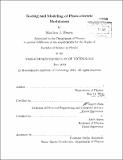Testing and modeling of photo-electric modulators
Author(s)
Weaver, Matthew J. (Matthew James)
DownloadFull printable version (6.982Mb)
Other Contributors
Massachusetts Institute of Technology. Department of Physics.
Advisor
Rajeev Ram and Erich Ippen.
Terms of use
Metadata
Show full item recordAbstract
Optical links are a promising alternative to the electrical interconnects that are currently used between chips within a computer. A crucial part of an optical link is a modulator, a device that converts an electrical signal into an optical signal. This thesis explores the physics of how these modulators operate. I built a general purpose optical and electrical testing station to perform these measurements. The optical transmission spectra of the set of modulators studied had extinction ratios in the range of 5 to 27 dB, which is sufficient for modulation. I developed analytical and T-Matrix models to extract physical parameters from the transmission scans, such as light transmission, loss in the ring, and index of refraction of the contact section. The modulators worked with an open eye up to frequencies of 600 MHz. A theoretical model was developed to match the data and experiment with injection and recombination dynamics. Finally, several design solutions are suggested to further improve the modulators and to move towards the goal of modulators that operate at 5 Gb/s.
Description
Thesis (S.B.)--Massachusetts Institute of Technology, Dept. of Physics, 2012. Cataloged from PDF version of thesis. Includes bibliographical references (p. 65-66).
Date issued
2012Department
Massachusetts Institute of Technology. Department of PhysicsPublisher
Massachusetts Institute of Technology
Keywords
Physics.